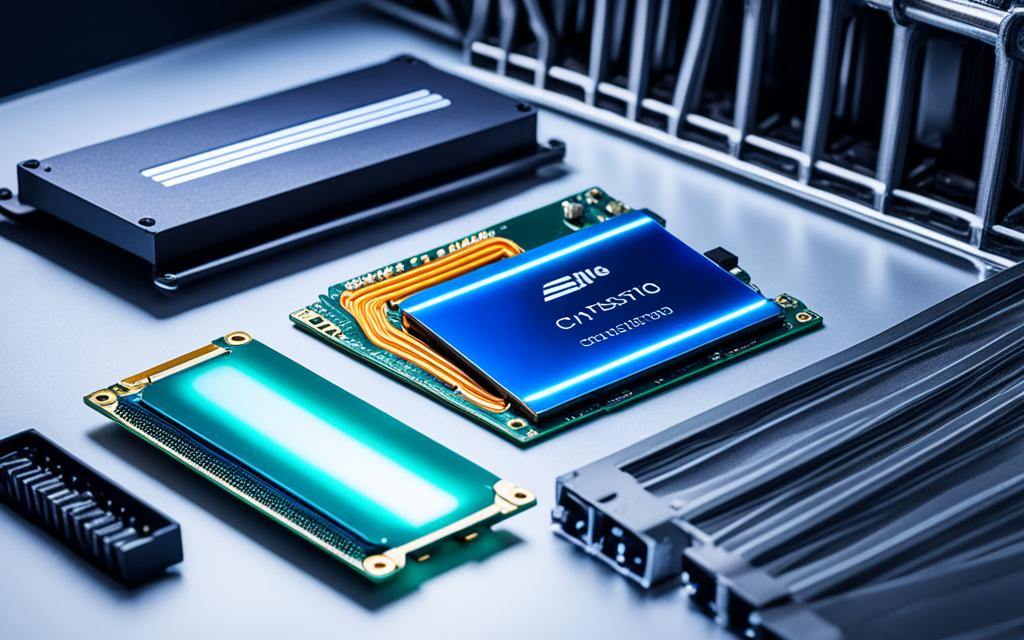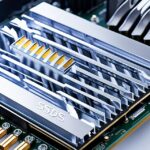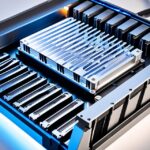Table of Contents
Choosing to add a heatsink to your M.2 SSD can change how well it performs and lasts. As M.2 SSDs get more popular for their fast speed and efficiency, people wonder if they need extra cooling. This question isn’t easy to answer because it depends on things like the type of SSD, your computer’s build, and how you use it.
Keeping your SSD cool is vital for its best performance, especially when it’s working hard. This can prevent overheating and slow-downs. Using the right cooling, like motherboard options or separate heatsinks, can greatly help your M.2 SSD run better123.
Key Takeaways
- M.2 SSDs can experience temperature ranges significantly affecting performance.
- Heatsinks are crucial for better heat dissipation, especially in high-performance tasks.
- Consider your system configuration when deciding on additional cooling solutions.
- Many mid to high-end motherboards include basic cooling features for M.2 SSDs.
- Monitoring SSD temperatures can prevent performance degradation and data loss.
- Aftermarket heatsinks may provide superior cooling compared to standard solutions.
Understanding M.2 SSD Technology
M.2 technology is a game-changer in computer storage, offering sizes smaller than older drives. It’s meant for expansion cards that fit inside computers, saving space and increasing speed. M.2 SSDs have brought a new level of performance to PC storage, with very fast read and write speeds4.
What is M.2?
M.2 isn’t just a new type; it changes how we think about SSDs. It works with different interfaces, like SATA and NVMe, to meet various needs. This means devices can use faster PCIe lanes for quicker data moves.
The Difference Between SATA and NVMe M.2 SSDs
SATA SSDs use an older connection, making them slower than NVMe SSDs. NVMe models use PCIe to go much faster, ideal for gaming or moving lots of data. For instance, the WD Black SN850X can hit speeds up to 7300 MBps5.
Generations of PCIe and Their Impact on Performance
Knowing about PCIe versions helps understand SSD speeds. Each new generation makes the bandwidth bigger for faster speeds and better performance. With PCIe Gen4, M.2 SSDs can reach top speeds, like the Crucial T705 hitting up to 14500 MBps5.
Why Cooling is Important for SSD Performance
Keeping M.2 SSDs cool is key to their performance. They operate best from 0 to 70 °C. Staying within this range boosts their effectiveness and life. Go beyond these temperatures, and you risk SSD overheating. This can mess up data and shorten the SSD’s life. Knowing why SSD cooling is crucial is very important.
Operating Temperature Ranges
SSDs work best at certain temperatures. Most Crucial SSDs should stay between 0 and 70 °C1. Going over 65°C might mean you need better cooling. This is especially true if you’re moving a lot of data often, as it affects performance1. While not all setups need heatsinks, they help when airflow is low or during heavy use6.
Effects of Overheating on SSDs
If SSDs get too hot, they slow down to avoid damage. Keeping them too warm for too long can lead to lost data or even break them7. It’s vital to use good cooling methods. This includes ensuring enough air moves in the case or adding cooling parts. This is key when doing big data transfers6. People who often move large amounts of data should watch their SSD’s temperature closely. This helps stop overheating before it happens1.
Do I Need a Heatsink for M.2 SSD?
Do you wonder if you need a heatsink for your M.2 SSD? The answer depends on a few things. Your SSD’s model, how you use your computer, and the warmth inside your PC all play big roles. Understanding these factors makes sure your SSD works well and lasts long.
Factors Influating the Need for a Heatsink
M.2 SSDs can get really warm, especially when they’re working hard. This is why thinking about a heatsink is important. For example, NVMe Gen 3 SSDs usually don’t need one. But, Gen 4 and 5 SSDs could get so hot they might need extra cooling. This stops them from getting too slow when they’re busy8. If they get too hot, it could also harm your data and shorten your SSD’s life. Keeping them below 50°C is best for smooth running9.
Evaluating Your System’s Airflow
How air moves through your computer is key for keeping M.2 SSDs cool. Good airflow helps stop heat from building up. This keeps your components cooler. Some motherboards, like the Ryzen 2nd Gen, even come with coolers for M.2 SSDs. But these coolers might not be big or metal enough to work well9. So, it’s good to check if your computer has good airflow. This can help you decide if you need to buy a better heatsink.
Motherboard Cooling Solutions
Today, many motherboards help cool M.2 SSDs, especially the NVMe Gen 3 types. These cooling solutions are often enough to keep them at safe temperatures8. But with Gen 4 and darker drives, cooling becomes even more important. Adding a heatsink might require you to use thermal pads. This makes sure the heatsink sticks well and takes the heat away properly. Doing this can get tricky, so you might want to ask a professional for help9.
| SSD Generation | Heatsink Necessity | Typical Operating Temperature |
|---|---|---|
| Gen 3 | No | Up to 70°C |
| Gen 4 | Yes (under heavy load) | Up to 80°C |
| Gen 5 | Usually Yes | Under 50°C recommended |
Comparing Cooling Solutions for M.2 SSDs
With the need for better storage getting higher, knowing about SSD cooling solutions is key. Many motherboards have built-in heatsinks. They provide enough cooling for everyday use. These heat spreaders do a good job keeping things cool under normal use, fitting those who don’t push their systems too hard.
Built-in Cooling Solutions
Built-in heatsinks work well for normal tasks, but might fall short for heavy-duty ones. Around 70% of SSD cooling in consumer devices comes from passive heatsinks on motherboards10. For tasks like big file transfers or gaming, these may not be enough. You might need better cooling solutions for such heavy work.
Aftermarket Heatsinks: Are They Worth It?
For better heat management, aftermarket heatsinks like the MP600 ELITE with Heatspreader are great. They not only cool better but use thermal pads for perfect SSD contact. This boosts efficiency. Designs like the 8 mm fin-type heatsinks from ATP can lower temperatures by up to 12°C, proving their value for those who demand top performance1110.
Performance of Different Cooling Methods
Choosing between built-in and aftermarket cooling depends on your specific needs and setup. About 30% of users look for extra cooling for intense tasks10. It’s vital to pick the right cooling technique carefully. The kind of thermal pads used also impacts cooling performance. Stretchy pads are good for making ideal contact, while spongy pads adjust to different component heights, offering flexible heat management.
For anyone serious about keeping their SSDs cool, understanding these points is crucial for better system performance.
Explore more about cooling options to find the perfect fix for your NVMe, tailored to your needs11.
FAQ
Do I really need a heatsink for my M.2 SSD?
Whether you need a heatsink depends on your M.2 SSD type, how much you use it, and your computer’s thermal environment. High-performance NVMe SSDs, especially Gen4 and Gen5, might need extra cooling. They get quite hot when under heavy use.
How do I know if my M.2 SSD is overheating?
Use software to watch your SSD’s temperature. If it’s often hotter than 70°C, think about getting a heatsink or other cooling methods.
What are the benefits of built-in cooling solutions for M.2 SSDs?
Some motherboards already have cooling like heatsinks. They work well for normal use, keeping your SSD cool. This helps your SSD work better for longer.
Can aftermarket heatsinks really improve my SSD performance?
Yes, aftermarket heatsinks manage heat better than typical built-in ones. They’re good for heavy computer use. They prevent slow-downs by avoiding overheating.
How does airflow within my PC impact the need for a heatsink?
Good airflow stops your PC from getting too hot. But even with good airflow, a busy or cramped PC might still need more cooling.
What types of M.2 SSDs are available?
M.2 SSDs mainly come in two kinds: SATA and NVMe. NVMe drives are way faster thanks to better connection to your computer.
How do I choose the right cooling solution for my M.2 SSD?
Look at your SSD’s model, how much you use your computer, your PC’s airflow, and if your motherboard helps cool down your SSD. Thinking about these things will help you pick between a standard heatsink or a better, aftermarket one.
Source Links
- https://www.crucial.com/articles/about-ssd/do-you-need-an-nvme-ssd-heatsink – Do you need an NVMe SSD heatsink?
- https://www.easeus.com/computer-instruction/do-i-need-a-heatsink-for-my-m2-ssd.html – Do I Need a Heatsink for My M.2 SSD [2024 Full Guide]
- https://rog-forum.asus.com/t5/amd-500-400-series/do-you-use-any-additional-cooling-for-m-2-ssd/td-p/774204 – Do you use any additional cooling for M.2 SSD?
- https://www.makeuseof.com/what-is-m2-nvme-ssd-heatsink/ – What Is an M.2 NVMe SSD Heatsink?
- https://www.pcmag.com/picks/the-best-m2-solid-state-drives – The Best M.2 SSDs (Solid State Drives) for 2024
- https://forum.level1techs.com/t/are-nvme-heatsinks-worth-it-990-pro/202418 – Are NVMe Heatsinks Worth It? (990 Pro)
- https://community.frame.work/t/are-ssd-heatsinks-worth-it-or-a-waste/27525 – Are SSD Heatsinks worth it or a waste?
- https://www.cgdirector.com/does-m-2-ssd-need-heatsink/ – Does Your M.2 (NVMe) SSD Need a Heatsink?
- https://www.minitool.com/lib/m2-heatsink.html – What Is M.2 Heatsink? Do NVMe SSDs Need Heatsinks? – MiniTool
- https://www.corsair.com/us/en/explorer/diy-builder/storage/should-i-use-my-motherboards-thermal-pads-for-my-ssd/ – Should you remove the thermal pads on your motherboard's SSD cooler?
- https://www.atpinc.com/tw/about/stories/overcoming-nvme-thermal-throttling-temperature – NVMe SSD Thermal Management: What We Have Learned from Marathons








